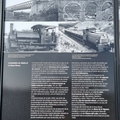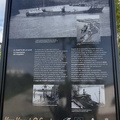Information Board outside the mining museum at El Granado (4) (via Google Translation)
(heading) THE PORT OF LAJA - Construction and planimetry of the loading dock
(top photo) First expansion of the Port of La Laja, in 1890. The warehouses were roofed to avoid the enormous dust that was produced.
(bottom photo) Cantabria ship loading ore in La Laja, around 1930.
(main text) The loading dock of the Port of La Laja was one of the most important for mining in our country during the last third of the 19th century and the first half of the 20th century. Its construction dates back to 1858, with the aim of being used as a loading dock for the export of manganese from the Santa Catalina mine that arrived at the dock in carts pulled by animals. With the commissioning of the railway, by the English company The Bede Metal, between 1888 and 1890 the wharf was expanded to accommodate the mineral, mainly pyrite, obtained from the exploitation of Cabezas del Pasto. In 1923, and with mining activity booming, the French company Saint Gobain would modernize the loading dock with the aim of accommodating ships with a greater draft and with more capacity to transport ore, but, above all, with in order to carry out unloading tasks at a higher rate. In addition, the depth of the river was increased so that ships with a draft of 17 to 18 feet and a carrying capacity of 2,000 tons could access it, even with low flow. With this expansion, the shipping facilities allowed the output of 70 tons of pyrite per hour. Upon reaching the Port of La Laja, the wagons were tipped over the top of the hoppers, tilting automatically. In order for the ore to reach the ships, it was unloaded from the lower part of the hoppers into wagons that, upon reaching the end of the dock, were automatically unloaded into two sleeves, or strainers, which took the ore to the holds. The strainers could rotate horizontally and vertically, by hand-moved tomes, to give way to ships or change warehouses.
- Created on
- Thursday 29 December 2022
- Posted on
- Sunday 1 January 2023
- Albums
- Visits
- 770
- Rating score
- no rating
- Rate this photo

